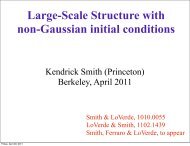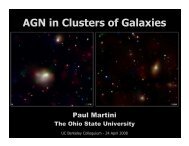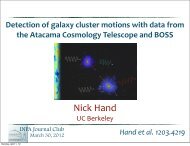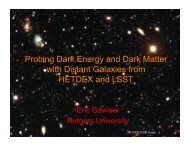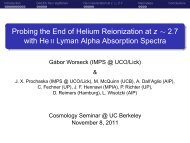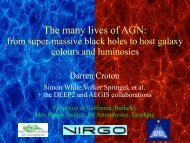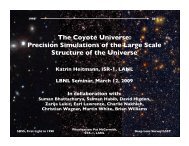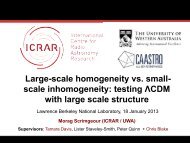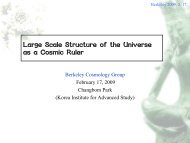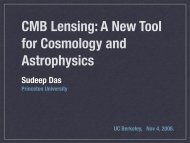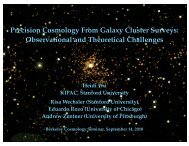Living fossils: A detailed view of distant Lyman break galaxies using ...
Living fossils: A detailed view of distant Lyman break galaxies using ...
Living fossils: A detailed view of distant Lyman break galaxies using ...
Create successful ePaper yourself
Turn your PDF publications into a flip-book with our unique Google optimized e-Paper software.
Roderik Overzier (MPA)<br />
Tim Heckman (JHU) - Guinevere Kauffmann (MPA)<br />
& The GALEX ScienceTeam<br />
(ApJ, in press)<br />
Berkeley - 5 Feb 2008 Roderik Overzier - Local LBG Analogs
Over<strong>view</strong><br />
Introduction<br />
• Starbursts, Galaxy Interactions, AGN<br />
• High redshift starburst <strong>galaxies</strong>: <strong>Lyman</strong> <strong>break</strong> <strong>galaxies</strong><br />
GALEX/SDSS selected sample <strong>of</strong> ``UV-luminous <strong>galaxies</strong>’’<br />
• Local Analogs to <strong>Lyman</strong> <strong>break</strong> <strong>galaxies</strong> ? (yes)<br />
HST observations<br />
• Morphological analysis<br />
• Connection between morphology and starburst<br />
• AGN (black hole) formation ?<br />
Updates on the story <strong>of</strong> galaxy formation at high redshift<br />
Berkeley - 5 Feb 2008 Roderik Overzier - Local LBG Analogs
Berkeley - 5 Feb 2008 Roderik Overzier - Local LBG Analogs
It is well established that galaxy interactions and mergers<br />
lead to enhanced star formation (starbursts):<br />
Berkeley - 5 Feb 2008 Roderik Overzier - Local LBG Analogs
Are AGN (black hole growth) the result <strong>of</strong> galaxy<br />
interactions as well?<br />
Largest SDSS-based study on QSO clustering (Li et al. 2007ab):<br />
Berkeley - 5 Feb 2008 Roderik Overzier - Local LBG Analogs
Conclusions on the connections between Starbursts +<br />
Galaxy Interactions + AGN:<br />
Observations:<br />
(interactions-AGN)<br />
Implications:<br />
Berkeley - 5 Feb 2008 Roderik Overzier - Local LBG Analogs
<strong>Lyman</strong> <strong>break</strong> <strong>galaxies</strong>: The typical<br />
<strong>galaxies</strong> that are forming stars at high<br />
redshift<br />
Resulting in “<strong>Lyman</strong> <strong>break</strong>” or “dropout” samples:<br />
z=6<br />
Berkeley - 5 Feb 2008 Roderik Overzier - Local LBG Analogs<br />
z=4<br />
z=3<br />
z=2
LBGs are used to probe, e.g., Cosmic star formation history<br />
• modest rise in cosmic SFR from z~6 to z~3 (Bouwens et al. 2006,2007)<br />
• maximum at z~1-3 (Lilly et al. 1996, Madau et al. 1998, Giavalisco et al. 2004)<br />
• dramatic decline towards z~0 (e.g. Schiminovich et al. 2005)<br />
• AGN history has a similar shape: AGN/BH formation more important at high-z!<br />
Berkeley - 5 Feb 2008 Roderik Overzier - Local LBG Analogs
Important links between local <strong>galaxies</strong> and high redshift <strong>Lyman</strong> <strong>break</strong> <strong>galaxies</strong><br />
z = 3 z = 0<br />
77% <strong>of</strong> z=3 LBGs end up in E or S0 at z = 0<br />
35% <strong>of</strong> local E or S0 have a LBG progenitor at z = 3<br />
LBGs at z=3<br />
E + S0 with LBG<br />
prog. prog.<br />
at z=3<br />
Sp with LBG prog.<br />
at z=3<br />
Other E + S0<br />
Blaizot et al. 2005<br />
(Slide courtesy from J. Blaizot)<br />
Berkeley - 5 Feb 2008 Roderik Overzier - Local LBG Analogs
Rest-frame UV vs. optical morphologies <strong>of</strong> <strong>galaxies</strong> at z~1 and LBGs at z~3<br />
<strong>galaxies</strong> at z~1 LBGs at z~3<br />
Papovich et al. (2005)<br />
Berkeley - 5 Feb 2008 Roderik Overzier - Local LBG Analogs
How to interpret LBG kinematics and morphologies?<br />
Fragmented SF in a (rotating) gaseous disk or merging (or both)?<br />
(Forster Schreiber et al. 2006, Law et al. 2007)<br />
Berkeley - 5 Feb 2008 Roderik Overzier - Local LBG Analogs
Finding Local Analogs to <strong>Lyman</strong> <strong>break</strong> <strong>galaxies</strong><br />
Why look for local analogs <strong>of</strong> LBGs?<br />
• LBGs are the dominant star forming population at high redshift (2
Strong Correlation between SFR and<br />
extinction in Starbursts in the local Universe:<br />
Extinction / E(B-V)<br />
Blue Compact Dwarf Galaxies<br />
NUV<br />
FUV NUV I<br />
Star Formation Rate<br />
(Ultra-) Luminous<br />
Infrared Galaxies<br />
Local analogs <strong>of</strong> LBGs<br />
Berkeley - 5 Feb 2008 Roderik Overzier - Local LBG Analogs
Discovery <strong>of</strong> a significant GALEX/SDSS sample <strong>of</strong> local LBG analogs<br />
GALEX (PI: Chris Martin)<br />
• NASA small explorer<br />
• UV satellite with 40 cm mirror<br />
• Capable <strong>of</strong> imaging in the Far- (1500A) and near-UV (2300A)<br />
• PSF ~4-5 arcsec<br />
• Survey telescope probing local (z=0-1) star formation history<br />
Heckman et al. (2005) and Hoopes et al. (2006)<br />
made a crossmatch between SDSS and the GALEX<br />
All-sky Imaging and Medium-deep Imaging Surveys (AIS/MIS)<br />
To match typical selection criteria <strong>of</strong> LBGs at high redshift:<br />
search for objects having both a large L FUV (SFR) and a<br />
large FUV surface brightness (compact in size), like this:<br />
Berkeley - 5 Feb 2008 Roderik Overzier - Local LBG Analogs
Far-UV Surface Brightness (L FUV /2πR h 2 )<br />
Far-UV Luminosity<br />
Berkeley - 5 Feb 2008 Roderik Overzier - Local LBG Analogs
UV-optical colors<br />
Properties <strong>of</strong> UVLGs<br />
Halflight radius (SDSS u-band)<br />
Berkeley - 5 Feb 2008 Roderik Overzier - Local LBG Analogs
SDSS Spectra indicate typical starburst spectra<br />
AGN excluded<br />
Metallicity<br />
Berkeley - 5 Feb 2008 Roderik Overzier - Local LBG Analogs
Stellar masses<br />
Properties <strong>of</strong> UVLGs<br />
Specific star formation rate<br />
Berkeley - 5 Feb 2008 Roderik Overzier - Local LBG Analogs
Summary <strong>of</strong> properties <strong>of</strong> `supercompact UVLGs’<br />
• Starburst <strong>galaxies</strong> at 0.1
SDSS<br />
Images<br />
<strong>of</strong><br />
Compact<br />
UVLGs<br />
show…<br />
compactness<br />
mostly<br />
What are they?<br />
Berkeley - 5 Feb 2008 Roderik Overzier - Local LBG Analogs
HST imaging program Cycles 15 & 16 (~100 orbits)<br />
31 nearest and brightest UVLGs (0.04 < z
UVLG morphologies I<br />
Berkeley - 5 Feb 2008 Roderik Overzier - Local LBG Analogs
UVLG morphologies II<br />
Berkeley - 5 Feb 2008 Roderik Overzier - Local LBG Analogs
UVLG morphologies III<br />
Berkeley - 5 Feb 2008 Roderik Overzier - Local LBG Analogs
UVLG morphologies IV<br />
Berkeley - 5 Feb 2008 Roderik Overzier - Local LBG Analogs
Summary <strong>of</strong> UVLG morphologies<br />
• Evidence for merger/interaction in each case<br />
• Evidence for merger only seen in optical, not in UV!<br />
• Starbursts concentrated in very small regions<br />
Berkeley - 5 Feb 2008 Roderik Overzier - Local LBG Analogs
Quantifying the Morphologies<br />
Low redshift: high S/N and well-behaved <strong>galaxies</strong>:<br />
• visual classification (E,S0,Sp,Irr,merger,etc)<br />
• automated classification through pr<strong>of</strong>ile fitting (Sersic,etc)<br />
High redshift: low S/N, different wavelengths (mostly UV), and <strong>galaxies</strong> have nonstandard<br />
types (LBGs):<br />
• Morphological parameters<br />
Gini Coefficient<br />
M 20<br />
CAS (Concentration, Asymmetry, Smoothness)<br />
(e.g. Abraham et al. 1996; Conselice et al. 2003; Lotz et al. 2004,2006; Scarlata et al. 2006)<br />
Interpretation <strong>of</strong> high redshift morphologies usually relatively with respect to common local<br />
redshift morphological types (artificially redshifted to higher redshift)<br />
However, this has several problems:<br />
• Low redshift <strong>galaxies</strong> not representative for high redshift <strong>galaxies</strong> (size, luminosity scaling)<br />
• No absolute morphologies at high redshift<br />
The UVLG sample <strong>of</strong>fers a unique test for LBG morphologies and trigger <strong>of</strong> star formation !<br />
Berkeley - 5 Feb 2008 Roderik Overzier - Local LBG Analogs
Measuring Morphological Parameters<br />
• Gini Coefficient (G) is a measure <strong>of</strong> the fairness <strong>of</strong><br />
distribution <strong>of</strong> the wealth (light) <strong>of</strong> a society (galaxy)<br />
over its people (pixels)<br />
• M 20 is the second order moment <strong>of</strong> a galaxy’s 20% brightest pixels<br />
• C is the concentration = 5 log(r 80 /r 20 )<br />
!<br />
G =<br />
1<br />
| X | n(n "1)<br />
(2i " n "1) | X i |<br />
Outcome may depend on S/N (z, L and, size, instrument), aperture diameter,<br />
Berkeley - 5 Feb 2008 Roderik Overzier - Local LBG Analogs<br />
n<br />
#<br />
i
Morphologies <strong>of</strong> star forming <strong>galaxies</strong> at z=2-4 observed with HST<br />
mergers<br />
bulges<br />
disks<br />
• Morphologies <strong>of</strong> LBGs lie in between spheroids and double-nucleated mergers<br />
• LBGs are more spheroid-like than disk-like<br />
bulges<br />
(from Lotz et al. 2004, 2006)<br />
Berkeley - 5 Feb 2008 Roderik Overzier - Local LBG Analogs<br />
disks<br />
z=4: 10-25% double (major merger?)<br />
30% spheroidal (bulge?)<br />
50% indetermined (minor mergers/SF disks/post-SB?)
Artificial redshifting the observed morphologies to z=1-4<br />
θ 2 = θ 1 (D A1 /D A2 )<br />
θ 1 /s 1 = b (θ 2 /s 2 ), b = binning factor<br />
Conservation <strong>of</strong> luminosity:<br />
4πD 2 L1 N 1 f ν (z 1 )(1+z 1 )-1<br />
In ADU/s:<br />
= 4πD 2 L2 N 2 f ν (z 2 )(1+z 2 )-1<br />
p(z 2 )/p(z 1 ) ∝ [(1+z 1 )/(1+z 2 )] 3<br />
Create `GOODS’ images <strong>of</strong> UVLGs<br />
z=1.5 (B),<br />
z=3-4 (V+i),<br />
Output scale 0.03 arcsec/pixel<br />
PSF ~ 0.12 arcsec<br />
Berkeley - 5 Feb 2008 Roderik Overzier - Local LBG Analogs
UDF depth COSMOS depth<br />
Berkeley - 5 Feb 2008 Roderik Overzier - Local LBG Analogs
Comparison <strong>of</strong> morphologies <strong>of</strong> UVLGs and LBGs - Results<br />
The morphologies <strong>of</strong> the resimulated<br />
UVLGs are very similar to those <strong>of</strong><br />
LBGs in GOODS/UDF:<br />
UVLGs are thus similar to LBGs in<br />
every physical property that we can<br />
measure<br />
The undegraded, optical HST images<br />
showed mergers/interactions in each<br />
case (as evidenced by companions,<br />
tidal tails/debris, and isophotal twists):<br />
It is therefore, by extrapolation,<br />
reasonable to conclude that LBGs are<br />
starbursts triggered during collisions <strong>of</strong><br />
relatively low mass, gas rich systems<br />
Berkeley - 5 Feb 2008 Roderik Overzier - Local LBG Analogs
Collisional starbursts have been suggested to be the dominant<br />
mechanism to turn gas into stars at high redshift:<br />
(Somerville, Primack & Faber 2001)<br />
Simulations/models predict that<br />
Collisional starbursts triggered by<br />
(minor) mergers are responsible for<br />
• 70% <strong>of</strong> SFRD at z=4<br />
• 45% at z=1.5<br />
• quiescent star formation<br />
dominates now<br />
This scenario seems to have<br />
been confirmed based on the<br />
sample <strong>of</strong> local LBG analogs<br />
Berkeley - 5 Feb 2008 Roderik Overzier - Local LBG Analogs
Star formation dominated by Super Starburst Regions (SSBs)<br />
53% <strong>of</strong> L U<br />
79% <strong>of</strong> L U<br />
• Contain typically 30-80% <strong>of</strong> the UV light!<br />
• 1 to several per galaxy<br />
• unresolved even with HST at z=0.1 (~100-300 pc)<br />
Berkeley - 5 Feb 2008 Roderik Overzier - Local LBG Analogs
Is there any evidence to suggest that the substructure <strong>of</strong> high-z LBGs is similar<br />
to the local LBG analogs? Compare with LBGs that are gravitationally lensed:<br />
“Deprojected” lensed LBG at z~4:<br />
Substructure <strong>of</strong> lensed LBGs very similar in luminosity (=SFR/mass) and size !<br />
(Franx et al. 1997, Ellis et al. 2003)<br />
Berkeley - 5 Feb 2008 Roderik Overzier - Local LBG Analogs
Properties <strong>of</strong> the Super Starburst Regions:<br />
30 Dor<br />
30 Dor<br />
• masses ~ 10 7 to 10 8 M o ,<br />
• ages ~ 6 Myr to few 100 Myr,<br />
• SFRs ~ 0.1 to 1 M o /yr,<br />
• may host (forming) globular clusters<br />
for a cluster formation efficiency <strong>of</strong> ~1%<br />
Berkeley - 5 Feb 2008 Roderik Overzier - Local LBG Analogs
Far-UV Surface Brightness (L FUV /2πR h 2 )<br />
Far-UV Luminosity<br />
Berkeley - 5 Feb 2008 Roderik Overzier - Local LBG Analogs
What do the “super starburst regions’’ and LBG ‘”knots’’ consist <strong>of</strong><br />
z=0.02<br />
z=0.02<br />
z=0.15<br />
z=0.15<br />
• LBG “knots” (~1 kpc) are blends <strong>of</strong> SSBs (~0.1-0.2 kpc)<br />
• SSBs are blends <strong>of</strong> bright star clusters (10 4-6 M o ,
Faint-end slope <strong>of</strong> UV LF:<br />
but<br />
An interpretation <strong>of</strong> the high redshift UV Luminosity Function (LF)<br />
α=-1.2 at z=0<br />
α=-1.8 at z=6<br />
(Wyder et al. 2005, Bouwens et al. 2007)<br />
Can we explain the steep faint-end slope <strong>of</strong> the high redshift LF <strong>using</strong> SSBs?<br />
Berkeley - 5 Feb 2008 Roderik Overzier - Local LBG Analogs
Can we explain the steep faint end slope <strong>of</strong> the high redshift LF <strong>using</strong> SSBs?<br />
The UV luminosity <strong>of</strong> an `LBG’ at time t is the sum <strong>of</strong> the luminosities due to all its prior<br />
starburst `events’:<br />
Distinguish between a slowly evolving, diffuse component, and a series <strong>of</strong> N discrete `bursts’:<br />
We have learned that LBGs come in `knots’ (~1 kpc), and each knot consists <strong>of</strong> smaller `SSBs’:<br />
It follows that at early times (z~6) the faint end <strong>of</strong> the UV LF will essentially be a sampling <strong>of</strong><br />
<strong>galaxies</strong> creating their first knot/SSB (N knot ~N SSB ~1, L diffuse ~0)<br />
The LF <strong>of</strong> star-forming regions from HII region to kpc scale is known to have a slope <strong>of</strong> α ≈ -2 !<br />
(Kennicutt et al. 1989, Meurer et al. 1995, Elmegreen & Efremov 1997, Zepf et al. 1999, Alonso-Herrero et al. 2002, Bradley<br />
et al. 2006 )<br />
Thus, assuming that the physics <strong>of</strong> star-formation does not change with redshift, we expect a<br />
steep(er) faint-end slope <strong>of</strong> the LF at high redshift compared to low redshift.<br />
Berkeley - 5 Feb 2008 Roderik Overzier - Local LBG Analogs
Summary<br />
• the GALEX/SDSS sample <strong>of</strong> compact UVLGs are LBG analogs in every<br />
measurable physical property (now also morphology)<br />
• the high resolution HST imaging <strong>of</strong>fers a rare <strong>view</strong> <strong>of</strong> the relationship<br />
between morphology and the main driver <strong>of</strong> star formation at high redshift<br />
• results indicate that local LBG analogs are all associated with highly<br />
dissipational mergers turning gas-rich <strong>galaxies</strong> into stars<br />
• consistent with collisional starburst predictions for high redshift <strong>galaxies</strong><br />
• rest-frame UV images not sufficient for establishing that they are mergers!<br />
(need faint features in rest-frame optical images)<br />
• predominance <strong>of</strong> unresolved SSBs are key to the correct interpretation <strong>of</strong><br />
LBG properties (e.g. sizes, morphologies, star clusters and evolution)<br />
• local LBG analogs may have a considerable AGN fraction, which could be<br />
important for BH/bulge growth when extrapolated to high redshift LBGs<br />
Thanks!<br />
Berkeley - 5 Feb 2008 Roderik Overzier - Local LBG Analogs



